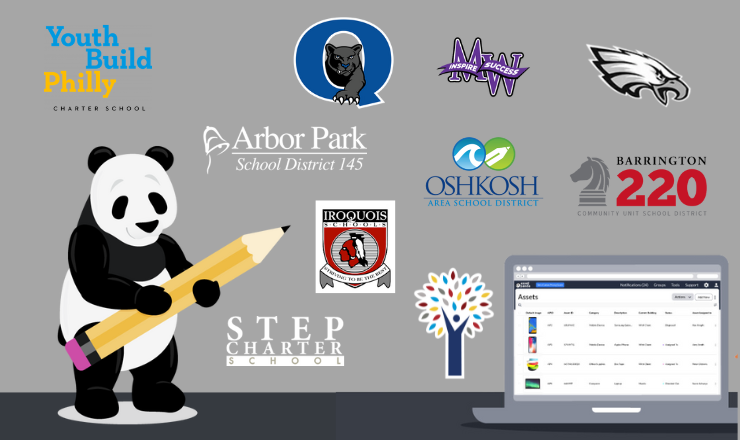Internal Audit Procedures for Fixed Assets in Education

Take Control of Your Assets
A personalized demo is just one click away.
Charter and K-12 schools everywhere rely on fixed assets to deliver the best quality education to their students. From desks to library shelves to sports equipment, it’s essential to keep tabs on your entire fixed asset inventory throughout the school year. While tracking your fixed assets in one centralized system is paramount, auditing your asset inventory is also vital to maintaining accurate data. To effectively conduct inventory audits on a routine basis, you need a clear internal audit process in place. In this blog post, we’ll discuss how to build efficient internal audit procedures for fixed assets as well as tips to implement and enforce your audit processes.
Why It’s Important to Have Internal Audit Procedures for Fixed Assets
Conducting an internal audit within your school or district means assessing the current state of your asset inventory. Your fixed asset inventory should consist of all physical items that are meant for long-term use (think desks, chairs, and gym equipment). An internal audit should not only consist of confirming your current number of fixed assets against your records but also corroborating each individual asset's location, condition, and status. By implementing effective internal control procedures for fixed assets, your school will realize various benefits:
Increased Productivity
With a clear picture of where your assets are and whether they’re available and in good condition, you can deploy the right assets to staff and students so they have the tools they need to teach and learn effectively.
Cost Savings
Your fixed assets are a large financial investment, which means it’s imperative to keep detailed asset records. By tracking the full history of your fixed assets and depreciation you can identify underutilized assets, increase their lifespan, and avoid unnecessary or duplicate purchases.
Enhanced Compliance
Maintaining detailed and up-to-date fixed asset records not only helps you optimize your often-limited budget but also helps ensure compliance with grants—particularly for assets purchased with grant money.
4 Steps to Building Your Internal Control Procedures
While the value of fixed asset audits is clear, we know that auditing your inventory may still seem like a daunting task. By following these best practices, you can implement repeatable internal audit procedures for fixed assets to continuously maintain accurate data. Let’s walk through 4 key steps to build an effective audit process.
1. Conduct an initial inventory of your fixed assets
Before you can effectively manage and audit your assets, it’s important to start with clean data. By conducting an initial inventory of your school or district’s assets, you’ll have a full picture of your fixed assets and can readily import this up-to-date information into your asset management or audit software.
2. Select the right audit software
Once you've taken stock of your fixed inventory, you need to ensure you have the right software in place to audit it effectively. If you already have an asset management platform, see what audit capabilities it offers – you may already have an audit solution at your fingertips!
Whether you're vetting your current fixed asset management solution or other audit tools, here are a few features to consider that will make your audits as efficient as possible:
- A mobile app with built-in barcode scanning: With the ability to access your audit software directly on a mobile device, your team members can conduct audits from any classroom or school without needing to carry around a laptop. Not to mention, built-in barcode technology will vastly save you time by auditing items with a single scan and eliminating the need for manual entry. This also allows you to easily create your own unique barcodes or QR codes and avoid the additional cost of scanners.
- Unlimited users: No matter the size of your school or district, you’ll likely want to split the workload and give school leadership insight into your audit results. By opting for a platform with unlimited users, you can easily assign permissions to other team members for audits and give stakeholders access to important data.
- Robust audit reporting: After auditing your fixed asset inventory, your work’s not over. Reviewing comprehensive reports of your audits to identify discrepancies, trends, or even underutilized assets is essential for improving accountability and making more informed decisions.
3. Create and assign internal audits
Once you have chosen the right audit software for your school, it’s time to start creating and assigning audits. As you and your team get acquainted with your platform, start small—consider auditing one classroom or department at a time to ensure you’ve created an internal audit procedure that feels repeatable and efficient. Once you’ve determined your chosen audit process within your software, create audits for each department, school, or even asset type (whichever makes the most sense to you!).
By building these workflows out upfront, you can easily conduct or assign these audits to team members on a regular basis. Of course, ensure that any colleagues you’re assigning audits to have been fully trained both in your audit software and on your internal control procedures for fixed assets (more on this in a bit). Further, if your software allows, set your audits to your desired recurring frequency (e.g., monthly or quarterly) to keep you on schedule.
4. Review audit reports and remediate any discrepancies
After your team has put your audit procedures into place, it’s time to report on the completed audits to see where there are any discrepancies in your inventory. While you’ll definitely want to review where any assets are missing altogether, it’s also important to factor in any unexpected asset damage, items in different locations than expected, or assets with different statuses than expected (e.g., assigned to an employee when they were expected to be available).
As you continually conduct your fixed asset inventory audits, you’ll be able to see any trends with asset discrepancies and, in turn, increase accountability amongst students and staff members. Further, ensure that your asset records are updated to reflect any new information from audits to increase data accuracy and compliance. However, if you’re conducting your audits through your chosen fixed asset management system, these records should automatically update once the audit is submitted.
How to Enforce Audit Procedures
Even after building and implementing a sound audit process, there are still some steps to take to ensure your internal control procedures are adopted across your school or district. Here are a few best practices to enforce your audit procedures.
1. Clearly document your procedures
The first step to ensuring adoption of your internal control procedures is to clearly document the processes and make that document accessible to all team members that will conduct audits. Aside from outlining each step of your internal audit procedures for fixed assets, be sure to include any relevant resources (e.g., links, help center guides), stakeholder information, and audit frequencies in your document.
2. Assign the right permissions to the right users
Before you can start assigning audits to your team, you need to ensure that all the necessary users have been added to your audit platform and assigned the correct permissions. For example, you’ll likely want to give your fellow asset managers comprehensive permissions to conduct audits and update asset records based on their findings. If your finance team isn’t directly involved in performing fixed asset inventory audits, you may opt to give them permissions to view asset records and generate robust reports.
3. Train your whole team
As is with any new process, it’s vital to train all staff members that may conduct audits on these procedures. While you’ll want to hold a live training session with all relevant staff members and stakeholders, don’t forget to have pre-recorded or live trainings for any new hires that will leverage these procedures in the future. Lastly, as you continually run audits and identify ways to streamline your internal procedures, make sure to update your documented processes and hold additional training sessions.
4. Create unique barcode labels for your fixed assets
No matter how efficient your new internal audit procedures for fixed assets are, there’s no denying that audits will still require quite a bit of your time. However, by creating unique barcode labels for each of your fixed assets, your team can vastly reduce audit times. This is especially true if your chosen asset management software offers a mobile app with built-in barcode technology, allowing you to scan barcode labels and swiftly conduct audits right from your mobile device.
Auditing Your School’s Fixed Assets with Asset Panda
Whether your charter or K-12 school relies on 1,000 fixed assets or tens of thousands, routinely auditing your inventory is the only way to maintain accurate asset data. Creating repeatable internal audit procedures for fixed assets is the first step to an effective audit process, but these processes must be paired with the right tool to maximize audit efficiency.
Asset Panda’s comprehensive software empowers schools of all sizes to track and audit their fixed asset inventories. Our highly configurable solution allows you to customize your internal control procedures for fixed assets and assign audits to unlimited users.
Using our mobile app with built-in barcode technology, your team can seamlessly create unique barcode labels for all your fixed assets and swiftly audit items with a single scan. As an Asset Panda admin, you’ll receive audit reports as soon as they’re completed and can customize your audit dashboards to easily track trends, discrepancies, and upcoming audits.
Ready to effectively manage and audit your fixed assets in one unified platform? Watch our on-demand demo now and request your personalized live demo to get started.
Take Control of Your Assets
A personalized demo is just one click away.
Related News & Press

Learn more from an Asset Panda expert
Get a FREE consultation with an asset tracking expert to find out how you can transform your asset tracking.
Contact our Sales Team at (888) 928-6112


